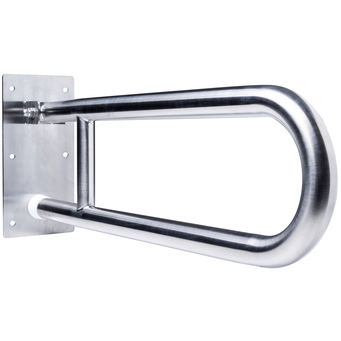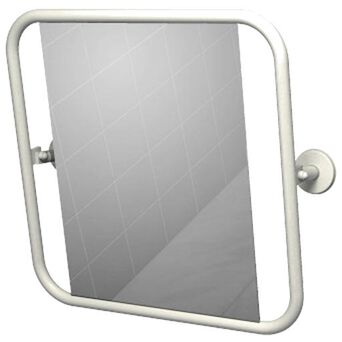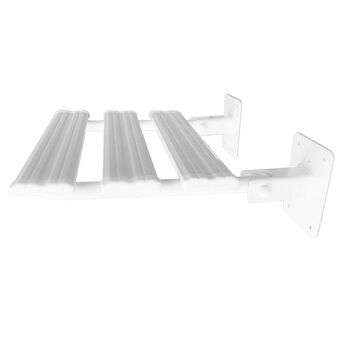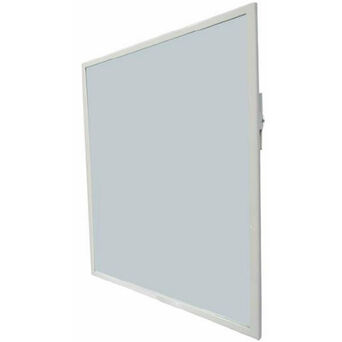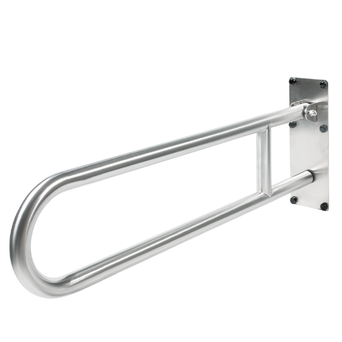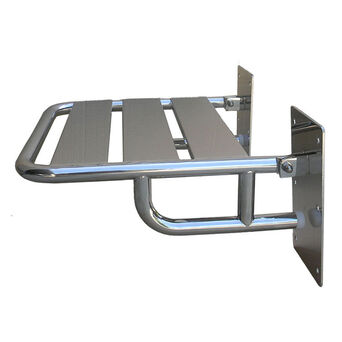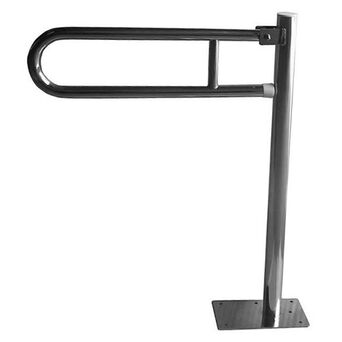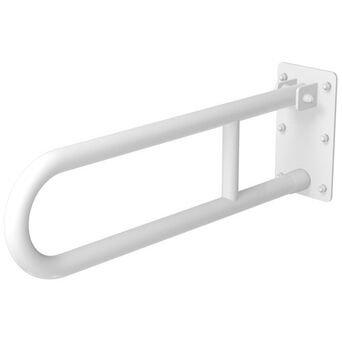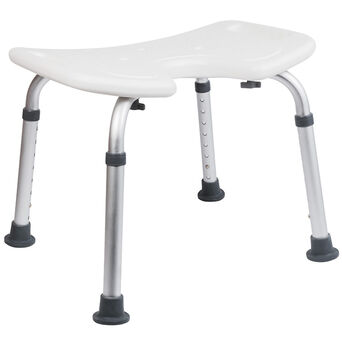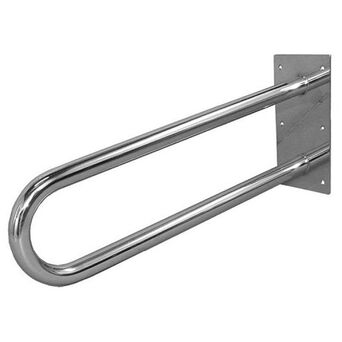How to design a toilet for the disabled? Dimensions, regulations
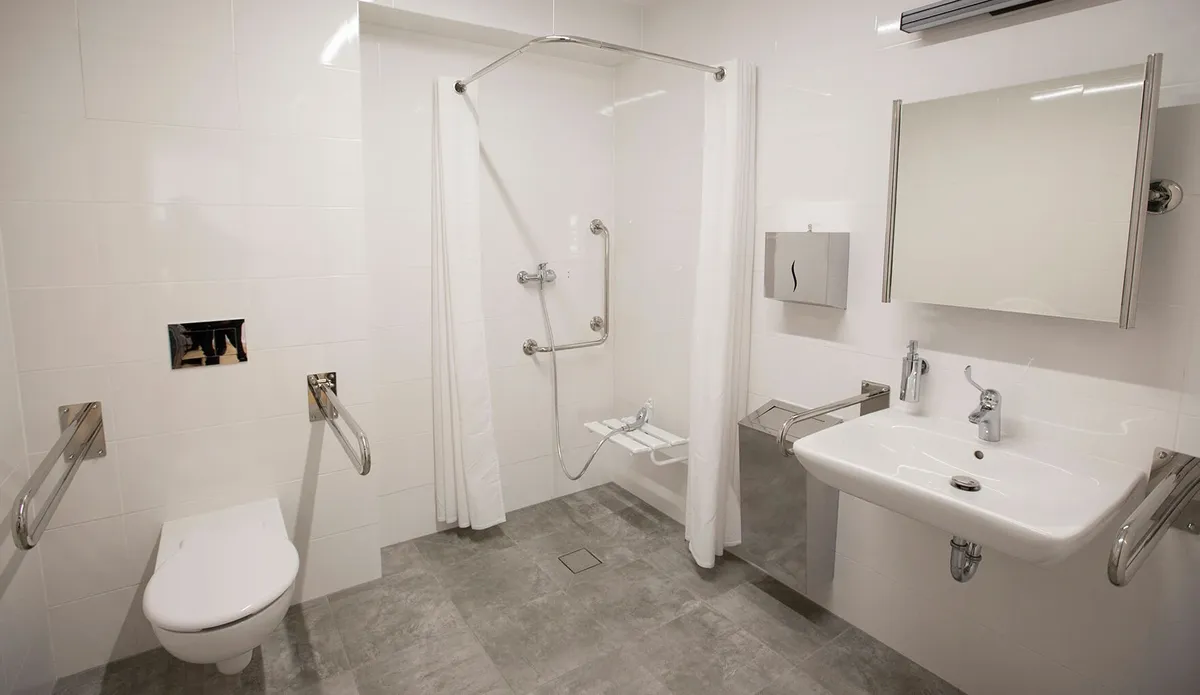
1. DESIGN "FOR ALL". NECESSARY OR REQUIRED?
2. IMPACT OF TYPE OF DISABILITY ON ROOM DIMENSIONING
- difference in mobility and range of upper limbs
- difference in seat height
- the general fitness of a wheelchair user
- the type and maneuverability of the wheelchair.
3. DIMENSIONING: GUIDELINES AND SUGGESTIONS FOR THEIR IMPLEMENTATION
3.1. General information
At least one sanitary room (toilet, bathroom) on each floor should be adapted to the needs of people with disabilities. Adaptation should include four main recommendations:
- providing adequate maneuvering space: minimum diameter of 1.5 m
- application in these rooms, as well as on the access road to them, doors for the disabled, i.e. those that do not have thresholds and whose minimum width is 0.9 m
- installing in the room at least one WC for the disabled and washbasins for the disabled
- installing handrails and handrails for the disabled, tilting mirrors that will improve, but above all make it easier for people with disabilities to use other devices.< /li>
3.2. In front of the toilet - front door
3.2.1 Characteristics
The entrance door is the first element that needs to be adapted to the needs of people in wheelchairs, which can easily become an insurmountable obstacle for them. All efforts of the designer and contractor aimed at creating ideal, optimal conditions inside the toilet for the disabled, ensuring full independence and comfort for the disabled will lose their sense if the entrance door is omitted in the adaptation process, which is quite often forgotten anyway . Therefore, in order to avoid unpleasant surprises, remember that the width of the door should be at least 0.9 m. Of course, you cannot overdo it the other way around. Doors wider than 1 m by their weight make it difficult to use the toilet instead of facilitating it. It is also important that when opening the door, and in fact its thickness does not reduce the width of the opening in the light of the frame.
Another important element is the threshold, or rather the lack of it, which would be necessary in this case. Unfortunately, in most cases this is not possible (because it indicates a difference in levels between the inside and the outside), which is why it often becomes one of the most troublesome obstacles. It is therefore worth eliminating the "obtrusive" obstacle in a different way, using for this purpose sub-threshold strips with a small slope that level the difference in levels. They can be installed permanently or temporarily. They are usually made of aluminum, steel, wood or hardened rubber. However, let's try to avoid the use of thresholds as often as possible, and ultimately limit ourselves to thresholds whose height does not exceed 2 cm.
The use of glazed doors is a separate case. In this case, it is required to use protection against impact with wheels at the bottom edge of the door, the height of which must not be less than 40 cm. The optimal solution is to use a safety glass pane.
Door handles are not only aesthetic (also important), but above all, an ergonomic shape that ensures a solid grip and support, eliminating the occurrence of dangerous, sharp edges. The type of handle used is conditioned not only by functional and ergonomic considerations. It also depends on the size and weight of the door itself. The limited room for maneuver of some users often requires a wide mountunder the handle, which should be placed at a height of not less than 80 cm. This is a huge facilitation that increases functionality.
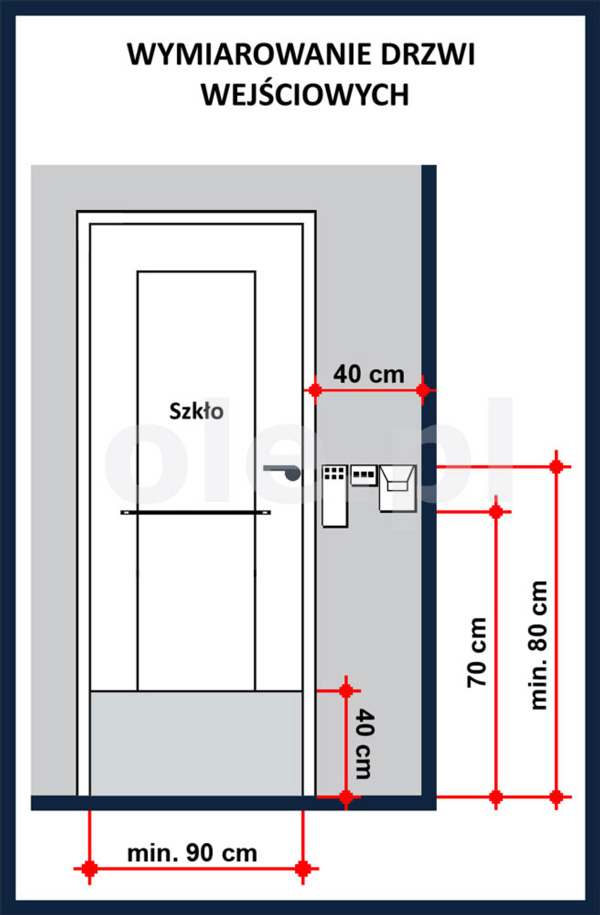
.jpg?1688075879423)
3.2.2. Maneuvering space
When planning the maneuvering space of vestibules and vestibules, it is assumed that it should be large enough not to cause trouble while moving, and to eliminate the possibility of hitting wheels against walls and corners. Otherwise, it would introduce the need to protect them with bumpers or quite high skirting boards, and this is an additional and unnecessary cost. It is also important to avoid a situation in which both doors of the vestibule are opened to the inside of the same room, because this significantly limits the space, otherwise it is necessary to extend the space by two lengths of the door leaf.
.jpg?1688075911200)
.jpg?1688075944402)
.jpg?1688075974050)
.jpg?1688076021834)
3.2.3.
It is important to place appropriate blanks to help you identify it. A disabled access sign should be placed on the toilet door and appropriate markings should be provided to facilitate understanding of the use of grab bars, handrails and other features adapted to the needs of people with disabilities.
3.3. Bathroom - washroom - toilet
3.3.1. Preliminary remarks
Mandatory equipment
The devices that absolutely must be included in the toilet/bathroom equipment include:
-
- Toilet bowl - adapted to the needs of people with disabilities.
- Sink - adapted to the needs of the disabled.
- Bathtub or shower (does not apply to toilets) - adapted to the needs of people with disabilities.
- Additional accessories: soap dispensers, paper towel containers, paper towel containers, toilet-paper containers, hand dryers - mounted at a height that allows free access to them for people in a wheelchair.
- First aid kit - placed in an accessible place, at a height of not more than 120 cm from the floor.
Maneuvering space
The basic guideline that should be taken into account when designing a bathroom for the disabled is to maintain a device-free maneuvering space (for a wheelchair), the minimum dimensions of which are 150x150 cm. This issue does not cause too many problems when it concerns rooms in newly constructed buildings. The situation is different with the adaptation of existing toilets. It often happens that the adaptation requires the demolition of walls, enlarging the door opening, changing the layout of the water and sewage or electrical installation and other minor treatments. The consequence of such far-reaching but necessary changes is also the surface depletion of the remaining rooms.
Toilet and bathroom are also often separate rooms. Then it is worth joining them together to obtain a larger surface. In order to avoid a number of difficulties described above, attempts are currently being made to force through the act a mandatory provision specifying the minimum dimensions of residential bathrooms, eliminating the need for subsequent modernization and incurring additional costs related to it.
In addition to the main, equipment-free maneuvering space, there are also maneuvering spaces in the room that allow free access to them. It is important that the maneuvering spaces at individual devices and the additional, main maneuvering space (150x150 cm) may overlap.
Design
In general, making a bathroom for the disabled that meets all the guidelines is not an easy matter, so it requires prior planning and preparation of an appropriate design that would ensure will be ergonomics and functionality, as well as safety for its future users. Its final appearance will be determined mainly by the permanent elements of every bathroom, the largest ones, such as: a washbasin for the disabled, a bathtub, a shower tray.
It is impossible to create a universal design that would take into account the needs of every user. The individual approach to each project is determined by the factors we have already mentioned at the beginning, including: the degree of disability and the range of movement limitations resulting directly from it, the range of the maneuvering area and the dimensions of the wheelchair. Nevertheless, a very general, minimum external outline of a bathroom of 200x240 cm is adopted, which should only be a starting point for further adaptation activities. The high degree of generalization is dictated by the varied, in each separate case, different structure of the building, which is differentiated by such elements as: windows, niches, load-bearing walls. Therefore, the given sizes should not be understood as final dimensions, but should be confronted with individual needs. Let us remember that sometimes a few centimeters can decide about the discomfort or convenience of the user.
3.3.2. Handles - necessary and necessary
Handrails for the disabled in toilet equipment are a must, even a key issue! Unfortunately, it also happens that their selection and installation make these accessories a real obstacle instead of helping. To some extent, this is also influenced by the variety of handrails for the disabled available on the market, yet the rich offer gives great opportunities in terms of appropriate equipment, while eliminating the difficulties associated with the individualization of needs. There are accessories of different lengths, but also of different pipe diameters (from 2 to 3.5 cm), which is especially important when the gripping abilities of the user's hands are smaller (elderly people). In such a case, handles for the disabled made of a pipe with a larger diameter are preferred. Installation height in the range of 75-85 cm (from the floor level), depends on height and buildbody of the user.
Multifunctional wall handrails for the disabled are most often used, which can be movable, fixed, mounted horizontally, vertically or vertically-horizontally (angular/broken handles) – definitely more functional than straight handles). It all depends on the individual needs and degree of disability of the user. These two factors determine the size, type and number of railings used. The point is to provide a disabled person with maximum safety and comfort. That is why handrails for the disabled are often corrugated, preventing the hand from slipping and increasing the grip, as well as handles for the disabled with inserts equipped with a fluorescent ring - especially useful when the lighting in the room is much weaker. In a situation where separating the free maneuvering space of the bathroom or toilet means significant restrictions in terms of separating the remaining space related to the installation of equipment, it is then worth using, for example, a tilting handrail for the disabled, especially recommended in those places where there is a need to install more than one handle e.g. at the toilet bowl. An additional facilitation turned out to be the appearance on the market of handles with auxiliary elements increasing their functionality. So we have Handrail for the disabled 60 cm, with rotating dispensers soaps or towel rails. These are the so-called special purpose handles.
3.3.3. Toilet bowl - a few tips
For people in a wheelchair, using a toilet bowl is often very difficult. This is due to negligence and mistakes made by the contractor adapting the toilet to the needs of people with disabilities. Lack of toilet equipment is the most common cause of problems. Here are some recommendations to avoid them:
-
- The distance of the toilet for the disabled from the back wall should not be less than 70 cm. This ensures free placement of the trolley along the bowl.
- The backrest should be 55 cm behind the front edge of the toilet bowl. This allows you to maintain a sitting position despite the distance from the toilet to the wall.
- The seat should be fixed and placed on the bowl so that it does not bend when changing from the wheelchair to the toilet.
- The recommended height of the bowl is 45-50 cm, but the most important thing is that the levels of the bowl and the seat of the stroller are the same - for this purpose, level regulating elements are used, e.g. seat pads.
- For people who have problems with bending down, we recommend toilet seat handles to help you sit down.
- Flush button: The flush button should be adapted to the capabilities of users, taking into account ease of pressing and operation. It is recommended that the button be easily accessible and placed at a height that will allow it to be operated by wheelchair users. A convenient solution is when the flush button is installed on the side or an automatic flushing system.
- The flushing device button should be located at a height of no more than 120 cm from the floor level.
- The cistern must not be foot operated.
- Installation height toilet paper container should be 100-120 cm counting from the floor level.
- The distance of the paper towel dispenser from the back wall of the toilet: 70-90 cm.
- Support mounting height Tilting handle: 80-85 cm .
- Emergency button - should be located within reach of the person using the toilet.
.jpg?1688076076133)
3.3.4. Bathing area
Anti-slip properties
An anti-slip surface is one of the most importanth elements when it comes to ensuring user safety. Its important function is revealed especially during the bath, when it is easiest to have an accident, when the risk of slipping is the greatest. This property also becomes the main criterion when choosing the material from which we will make the floor in our bathroom. Therefore, it is less important whether it will be terracotta, natural stone or impregnated wood. It is important that the floor gains anti-slip properties. Supplement and at the same time a condition for maintaining full safety, are additional elements of equipment supporting anti-slip properties. It is worth putting a mat or mattress on the bottom of the bathtub. Mats of various sizes are perforated or have appropriate tabs to eliminate the likelihood of slipping. They are made of special plastic or rubber. In the case of shower trays, the situation is a bit different, because most of them have a factory-made non-slip (grooved) texture. When the shower tray is made of terracotta, it is necessary to use anti-slip mats. The shower tray can be profiled with ceramic tiles, mosaic tiles or covered with a hardened and secured concrete screed. For the elderly, special acrylic or stainless steel shower trays with a non-slip, perforated surface with a minimum slope are installed.
Dimensions, key guidelines and solutions
Shower tray
-
- Minimum shower tray area: 90x90 cm.
- Slope (towards the drain): 1-2%.
- The grille should be under the shower seat.
- Height of shower seat: 43-48 cm.
- The seat should be facing Disabled Shower Faucet.
(In terms of seats, we have a choice of fixed or tilting seats: ready-to-install shower sets; armchairs and benches with openwork seats made of plastic or lined with a delicate touch of vinyl to increase comfort, seats with armrests and backrest, shower panels with a hydro function for people taking a bath in a sitting position are real comfort).
-
- Mounting height angle handle (vertical-horizontal): 80-85 cm.
- It is worth using low, accordion-shaped covers that spread to the sides at an angle of 180º. They perfectly replace solutions based on the complete closing of cabins. Sliding covers make it easier for people in wheelchairs to use the paddling pools.
.jpg?1688076094832)
Bathtub
-
- The length of the bathtub - depends on the user's needs, but not less than 150 cm.
- Width for comfort: 70-80 cm.
- Bathtub depth: 42-38 cm.
- It is important to adjust the level of the stroller seat to the height of the upper edge of the bathtub (preferably when they are the same). The height of the edge should not exceed 50 cm (for wheelchair users) or 60 cm (for other disabled persons).
- Getting in and out of the bathtub is greatly facilitated by special, imposed benches - seats hung on the bathtub (they cannot move during use), or modern bathtub lifts, such as, for example, a battery lift with a waterproof remote control that fits into rectangular bathtubs.
- Elderly people who have trouble walking can use stairs with handrails or a ladder attached to the ceiling to facilitate the use of the bathtub.
- A competitive solution is reinforced acrylic bathtubs with the function of an opening side.
- In order to completely eliminate the risk of falling, it is worth spreading a mat or a non-slip rug by the bathtub.
- The bathtub mixer should be selected in such a way that the spout, with its length and shape, does not pose a risk of injury.
- The battery should be lever-operated, push-button, or automatic. Do not use tap-operated faucets.
- The minimum length of the hose for the shower head should be 150 cm.
- Allow the user to hang up the handset or use it by hand.
- Thermostats and water temperature sensors eliminate the risk of scalding - especially important when the user has heat sensation disorders.
- When using bathtub screens, make sure that they will not hinder the use of fittings or the access to the bathtub. The guide of the screen cannot be attached to the edge of the bathtub.
.jpg?1688076113948)
3.3.5. Washbasin
Dimensioning
-
- The maneuvering space in front of the washbasin is 90x120 cm, with the longer side lying on the axis of the washbasin, with no more than 45 cm of this space under the washbasin.
- Suspension height: the bottom of the washbasin must be above the knees of a wheelchair user (min. 70 cm).
- Height of the washbasin top (upper edge): 85 cm.
- Mounting height of the lower casing (siphon, frame): min. 65 cm. Of course, in this situation, you can use the best solution, which are siphon-free washbasins.
- Comfortable width of the sink chamber: 60-70 cm.
- Comfortable depth of the sink chamber: 50-60 cm (or a small sink built into the countertop).
- The mounting height of the supporting tilting handle: 80-85 cm.
- Height of mirrors: not higher than 100 cm (counting from the floor level).
- Contraindications and recommendations
- It is not recommended to use pedestals or semi-pedestals, which, due to their large size, make it very difficult to drive a wheelchair to the washbasin from the front side, or even make it impossible to do so.
- There must be no sharp or rough elements under the sink.
- When choosing bathroom faucets for the disabled remember about the user's convenience. This small piece of equipment is often incorrectly selected. We have batteries that are activated by a lever, button or electronic sensor, i.e. touchless batteries. They are also equipped with a thermostat or an optoelectronic sensor (for people withhand weakness). We should also remember that the faucet should have an extended spout.
- Do not use tap operated batteries.
- Hot water connection and sink drain should be thermally insulated or installed in a way that prevents direct access to them.
- It is recommended to mount Tilting mirror with an adjustable angle of inclination.
.jpg?1688076145773)
3.3.6. Accessories
Bathtub or shower tray, toilet bowl, washbasin, handrails, mirrors, A touchless soap dispenser is of course necessary equipment that every bathroom for the disabled should have, but not the only ones. After all, there are also furniture, various types of cabinets that must be arranged in such a way that, on the one hand, they do not occupy a free maneuvering surface, and on the other hand, they are fully accessible. Therefore, the cabinets are hung at a height of about 35-40 cm from the floor level, so that all shelves and drawers are within reach. Cabinet doors should open up to the angle of 180º and it is not an exaggeration, because only such an opening angle will provide wheelchair users with full access and comfort. You can also use sliding doors, blinds or blinds. A good solution that supports the comfort and safety of the user is a heated floor, which makes the floor drying time much shorter, so the risk of slipping is also lower.
Glass elements, if they are part of the equipment, should be made of the so-called safety glass, i.e. glued glass. An important issue, also or above all from the point of view of safety, is the electrical installation. There are several restrictions related to this issue:
-
- Electrical sockets should be equipped with a hermetic flap protecting against water ingress.
- They should be located at a distance of not less than 60 cm from the water source.
- The mounting height of the sockets is in the range of 40-110 cm from the floor level.
- In terms of ensuring safety, it is also important that all the accessories and utensils we choose have blurred, smooth shapes. The same applies to the edges of the bathtub, countertops or corners.
3.3.7. Lighting requirements
Lighting in the bathroom for the disabled plays an important role, both in terms of functionality and safety. Properly selected lighting can make it easier for people with various types of disabilities to use the room. Here are some guidelines for lighting in a disabled bathroom:
-
-
Light intensity: Lighting should be bright enough to allow people with disabilities to see clearly and move around safely. In rooms with obstacles such as doors, walls or furniture, adequate lighting should be used to minimize the risk of tripping.
-
The right color temperature: It's important to choose lighting with the right color temperature. It is usually recommended to use lamps with a warm color (around 3000K), which provides a pleasant and natural light.
-
Emergency lighting: It is recommended to install emergency lighting in the disabled bathroom. In the event of a power failure, emergency lighting will provide people with disabilities with sufficient light to move around and use the toilet safely.
-
Lighting above the mirror: The mirror in the bathroom should be adequately lit to enable people with disabilities to perform hygiene tasks such as shaving, applying make-up or washing their face. It is recommended to use side or top lighting that diffuses the light evenly.
-
Light switches: It is recommended to use light switches in the bathroom for the disabledthat are easy to use and accessible to people with various types of disabilities. Push-button, sensor or elbow-operated switches can be used.
-
Avoiding glare: Avoid lighting that causes glare in the mirror or other surfaces, as this can obscure visibility and negatively impact bathroom comfort.
-
3.4. What are the most common mistakes we make?
- By not following the rules of ergonomics, we incorrectly arrange the elements of equipment, thus creating an obstacle course.
- The height of the devices is often not adapted to the needs of a disabled person.
- Unjustified excess of handles and devices in a small bathroom for the disabled, resulting in a significant reduction of maneuvering space.
- Too narrow door (less than 90 cm).
- Threshold too high (more than 2 cm).
- Mounting devices, handrails and bathroom furniture on plasterboard partition walls without additional reinforcement (cabinets, handles, taps) or special frames (for hanging sanitary devices). Then there are breakages, for example, of the railing with a fragment of the wall.
- Incorrect mounting height of electrical sockets, cabinets, shelves.
- Use of rugs and runners on which the wheelchair wheels slide.
After all, any elements protruding beyond the plane of the wall (elements of sanitary installations, pipes, radiators, fans, etc.) must not limit the free maneuvering space needed to move freely on a wheelchair.
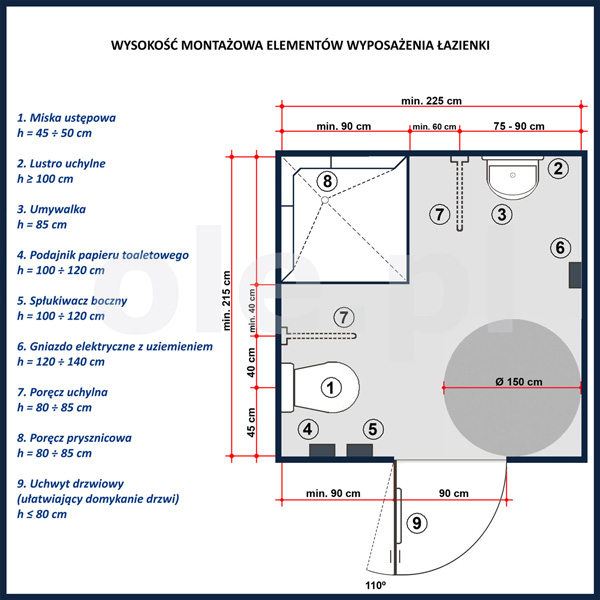
4. CONCLUSION
Remember that all the recommendations presented above are created for people with disabilities to provide them with the greatest possible comfort and enable them to act independently, while feeling safe, but not let's also forget that these activities translate to a large extent into the freedom and safety of using space by able-bodied people. On the other hand, visually impaired people will be greatly helped by the introduction of clear contrasts on the walls, because we should know that people with disabilities are not only those with mobility impairments.
All rights reserved. No fragment of the publication (text, graphics, images, photos, files and other data) presented in the OLE.PL online store may be reproduced or distributed in any form and in any way without prior permission. All trademarks, logos, proper names and other data are protected by copyright and belong to their owners.

